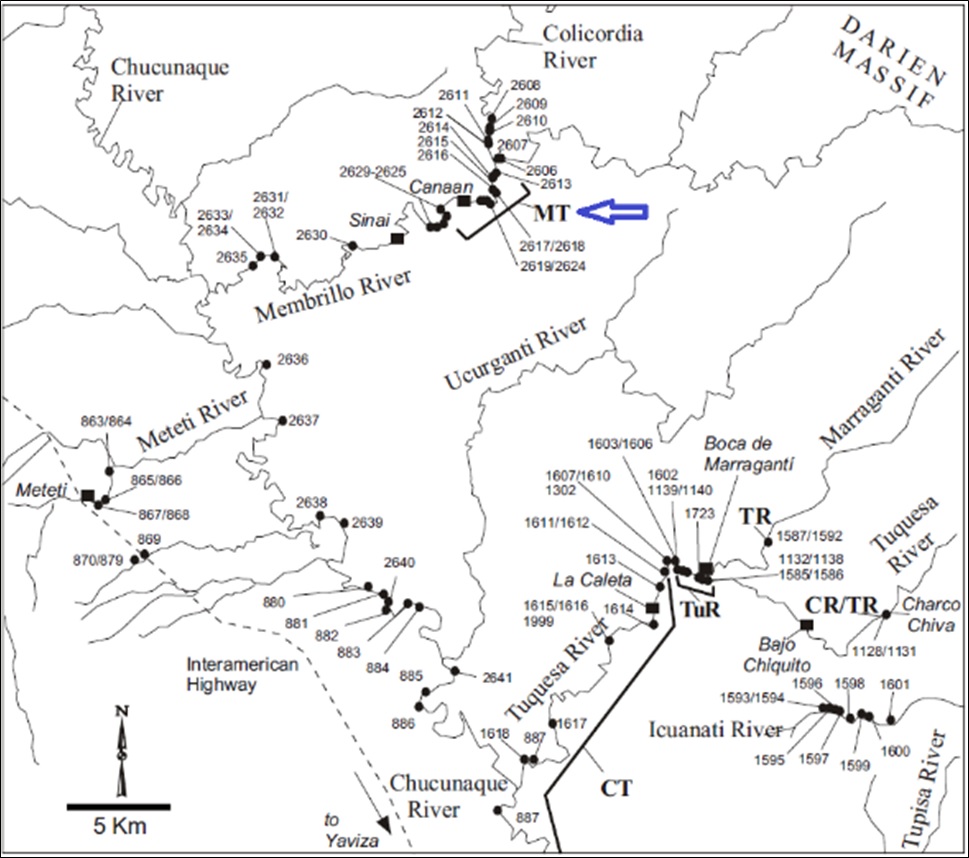Membrillo Fm
Period:
Neogene
Age Interval:
Lowest part of the Upper Miocene (Tortonian) - Coates et al. (2004)
Province:
Eastern Panama
Type Locality and Naming
Named for the Membrillo River by Coates et al. (2004)
The stratotype lies on the Membrillo River (Figure 1).
[Figure 1. Locality of the Membrillo Fm stratotype (MT). Coates et al. (2004).]
Synonym:
Lithology and Thickness
The base of the Membrillo Fm denotes the transition from the coarser thicker sediments of the shallow zone of the Chucunaque-Tuira Basin around the Chico and Tupisa Rivers region, westward into finer-grained (and deeper-water) deposits of the Bayano Basin. The Membrillo Fm is the lateral equivalent of the Tuira Fm. It consists mainly of blue gray, conchoidally fracturing, blocky and shelly mudstone with abundant slabby concretions in the upper portion. In the lower portion, there are frequent mollusk shell beds, 20 cm thick sandstone units, and occasional volcanic cobble horizons.
Thickness: About 150m. Its upper contact consists of blue-gray, blocky and shelly mudstone similar to that of the Tuira Fm (the upper contact of the Membrillo Fm is not exposed at the stratotype but there is an abrupt transition from mudstone to cobble conglomerate). The lower portion includes volcanic cobbles with frequent molluscan shell beds and 20-cm-thick sandstone units (the lower contact is not exposed at the stratotype). Gurocak-Orhun et al. (2017)
Lithology Pattern:
Sandy limestone
Relationships and Distribution
Lower contact
Upper contact
Regional extent
The Membrillo Fm is known only from the Membrillo River but extends westward into the Bayano Basin.
GeoJSON
{"type":"Feature","geometry":{"type":"MultiPolygon","coordinates":[[[[-79.61,9.61],[-79.48,9.64],[-79.23,9.6],[-78.99,9.56],[-78.49,9.45],[-78.08,9.29],[-77.84,9.09],[-77.4,8.7],[-77.35,8.59],[-77.3,8.42],[-77.18,8.02],[-77.26,7.82],[-77.39,7.66],[-77.56,7.46],[-77.73,7.31],[-77.83,7.24],[-77.89,7.24],[-78.01,7.33],[-78.25,7.61],[-78.38,7.9],[-78.43,8.14],[-78.4,8.31],[-78.51,8.49],[-78.64,8.67],[-78.88,8.86],[-79.18,8.99],[-79.35,9.03],[-79.37,9.04],[-79.42,9.09],[-79.52,9.13],[-79.52,9.17],[-79.54,9.21],[-79.54,9.3],[-79.54,9.35],[-79.62,9.34],[-79.7,9.33],[-79.8,9.41],[-79.75,9.49],[-79.61,9.61]]]]}}
Fossils
Age
Coates et al. (2004) tentatively assigns it to the lowest part of the upper Miocene.
Age Span:
Beginning stage:
Serravallian
Fraction up in beginning stage:
0.25
Beginning date (Ma):
13.27
Ending stage:
Serravallian
Fraction up in the ending stage:
0.75
Ending date (Ma):
12.17
Depositional setting
Sediments of the Membrillo Fm were deposited under middle bathyal (500-1500 m), oxygen-deficient conditions. Whereas many of the benthic foraminiferal taxa are most abundant at upper bathyal depths, others are characteristic of middle bathyal depths.
Depositional pattern:
Additional Information
References: Coates et al. (2004); Gurocak-Orhun et al. (2017).
Compiler:
Jacques LeBlanc (2021), Stratigraphic Lexicon: The Onshore Cenozoic Sedimentary Formations of The Republic of Panama. Biosis: Biological Systems, 2(1), 173 pp. https://doi.org/10.37819/biosis.002.01.0095 (or via https://sites.google.com/site/leblancjacques)
